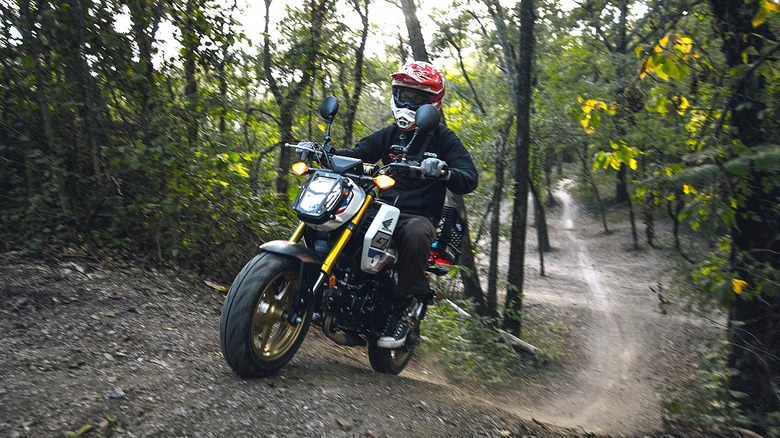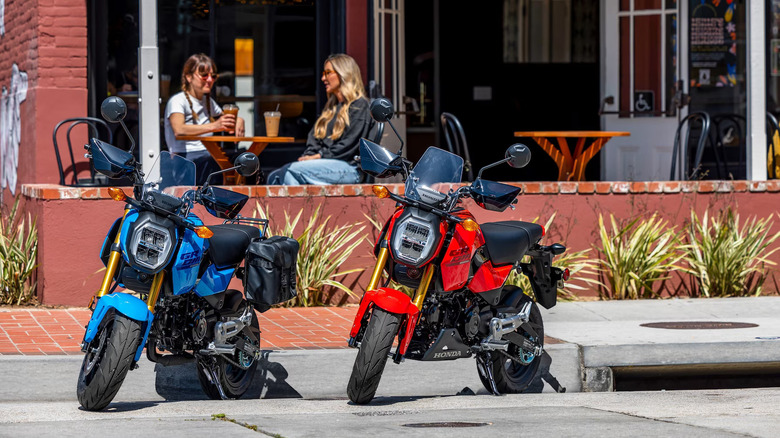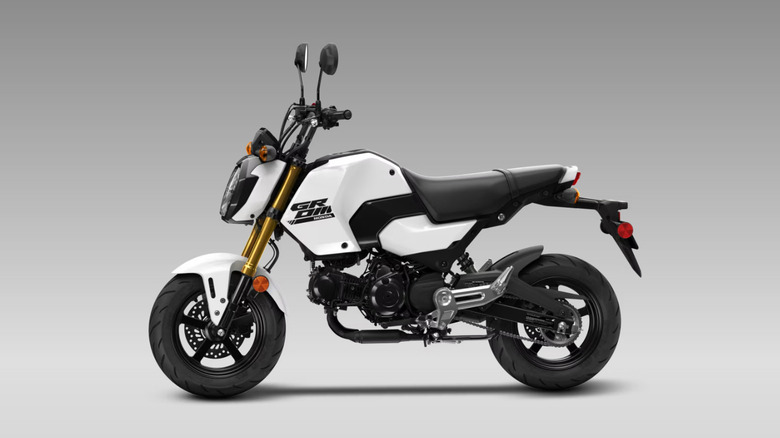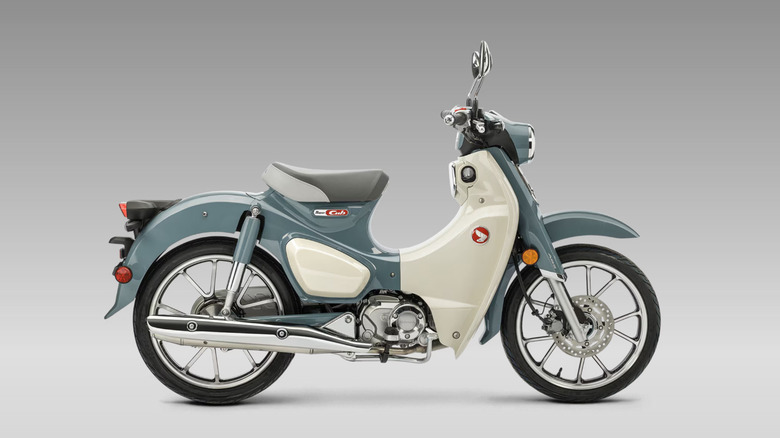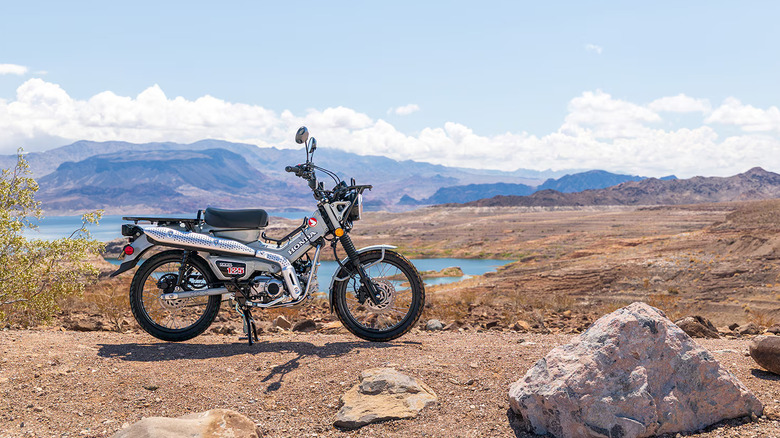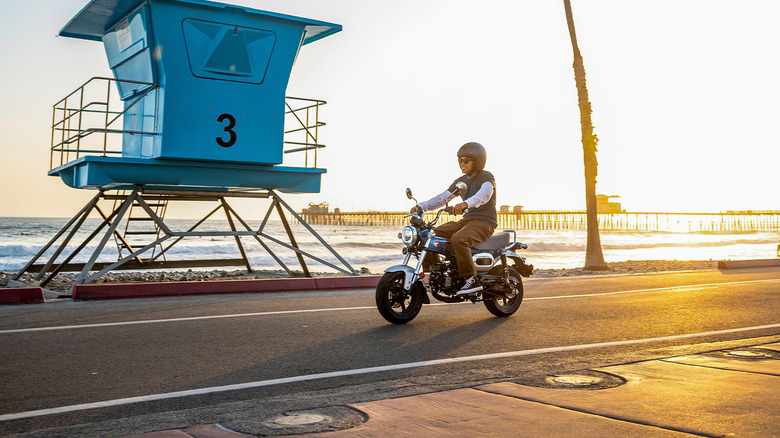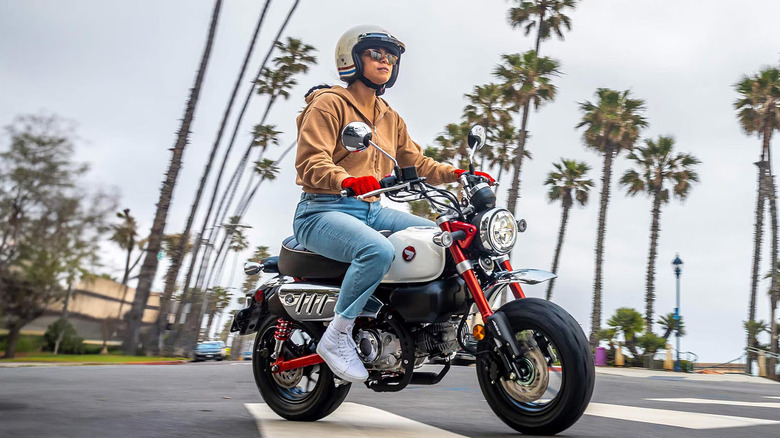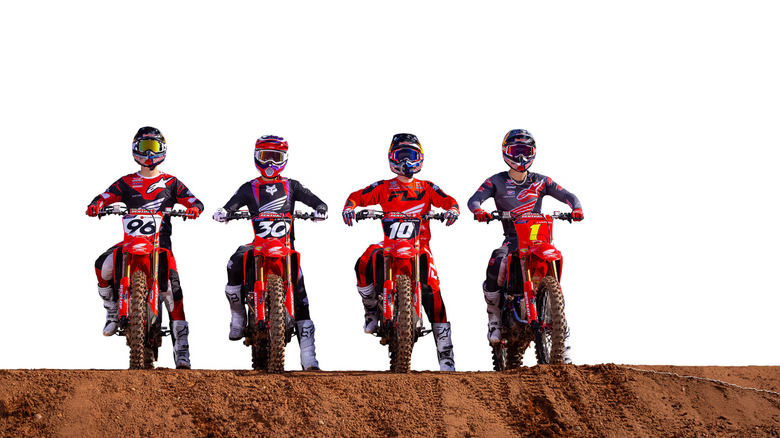Every Honda Mini Bike You Can Buy, Ranked By Price
Mini motorcycles are great fun to ride, being nimble, lightweight, and most importantly, fairly affordable. Depending on their engine size, many mini bikes are capable of reaching a top speed of around 35 mph, or thereabouts, which is why they are great for young riders. And, mini bikes are becoming increasingly popular, with some mini motorcycles even available at Tractor Supply. One WiseGuy report suggests that the market for this class of bike is valued at just under $2 billion. But what exactly is a "mini-bike"?
Well, some prefer a tubular frame with a lawnmower engine. Others will say that the weight must be under 132 lbs with a seat height lower than 700 mm. The truth is that opinions differ, but a mini bike is broadly going to be a smaller-than-usual frame, with small-diameter wheels, an engine typically under 125 or 150cc, and absolutely no frills.
There are several names to choose from in this market, like Coleman, Drift Hero, Massimo, Greenworks, and many more. Legacy makers like Yamaha and Honda also make several models, though prices are on the premium end. Even so, many of the mini bikes on this list are quite affordable, though a couple do push the $5,000 mark, at which point the value proposition begins to fade a bit. Here are all the Honda mini motorcycles on the market today.
Navi -- $1,999
Coming in with a from-showroom MSRP of $1,999 is the Honda Navi, and it is actually one of the most affordable mini motorcycles on sale right now. Readers should note that there's a $300 destination fee with every single bike on this list, bringing the ride-home total to $2,299 — at the time of writing, anyway. For that money, the bike comes with a four-stroke, twin-valve engine that displaces 6.6 ci (109 cc) across a lone cylinder, paired to Honda's "automatic V-matic belt drive", which is a continuously variable transmission, or CVT.
This powerplant setup produces 6.6 lb-ft of torque at 5,000 RPM, alongside 7.9 hp at 7,500 RPM, which is actually a decent bit of punch for a bike that weighs just 234 pounds; and that's in running order. The front suspension is an inverted fork that has 3.5 inches of travel, while the rear is a simple monoshock that has a slightly less 2.8 inches of travel. Both the front and rear brakes are 130 mm drum units that are part of Honda's CBS, or combined braking system.
While it has other benefits, the main function of the CBS is that it will actuate both front and rear drum brakes even if only one brake lever is pressed. The rider will sit just 2.5 feet (30 inches) above the ground, and will ride on tubeless 90 mm tires with a 12 inch rim at the front and a 10-inch one at the back.
Ruckus – $2,899
The Honda Ruckus is about 40% more expensive out the door than the Navi, coming in with a base MSRP of $2,899, and that's without the $300 destination fee tacked on. However, it is definitely a talking point, looking like a cross between a naked mini bike and a commuter scooter. Unlike the Navi's air-cooled engine, though, the Ruckus features liquid cooling, though it's still a twin valve, four-stroke unit. The displacement, however, is much lower, coming in at just 3 ci (49 cc), and it uses the same V-matic transmission. The reduced size drastically drops the power output down to 4.4 hp, and we couldn't even find an accurate source for the torque, but the weight also isn't much lower — 194 pounds in running order with all fluids and fuel.
Speaking of fuel, the Ruckus can hold an impressive 1.3 gallons in the tank, affording the rider almost 150 miles of range, thanks to its estimated 114 mpg economy. For suspension, the front has a telescopic fork that can move 1.9 inches, and the rear is a lone shock that has 2.6 inches of travel. The seating height for the Ruckus is 28.9 inches above the ground, and the brakes are 95 mm drums, both at the front and the back. The fat tires are interesting, being 120 mm wide at the front and 130 mm at the rear, with a 90% sidewall and 10-inch rims on both.
Grom -- $3,599
Possibly the most well-known Honda minibike of them all is the Grom, which is available in three different levels. The first of these levels is the base Grom, no frills, that costs a not-insignificant $3,599, with $300 for delivery, bringing the out-the-door price to $3,899. It's pushing the limits of what defines a minibike, coming in with a displacement of 7.6 ci (124 cc), still with twin-valves and in a four-stroke layout. This engine produces a respectable 9.7 hp at 7,000 RPM along with 7.7 lb-ft of torque at 5,500 RPM.
The other major differences are that the Grom ditches the V-matic CVT for a five-speed manual transmission with chain final drive, and it also comes with fuel injection, while the Ruckus and Navi have carburetors of 18 and 16 mm, respectively.
The suspension on the Grom is also upgraded, with a conventional fork at the front that has 3.9 inches of travel, and a standard monoshock at the back with a generous 4.1 inches of travel. Despite the bigger engine and a bigger fuel tank, the Grom weighs less than the Navi, coming in at 224 pounds in running order versus the Navi's 234 pounds. The Grom can hold up to 1.6 gallons of gas, and it also has an estimated fuel economy of 161 mpg. This means the Grom could theoretically go about 250 miles between fill-ups, which is a pretty decent range.
Grom SP -- $3,699
For $100 more than the regular Grom, a word meaning young surfer, buyers can get the Grom SP, which is supposed to be a step above the base model. The engine is the same 7.6 ci (124 cc) single overhead cam, twin-valve unit from before, and so is the transmission. Anyway, there is absolutely no difference mechanically between the SP and the base Grom – as this handy pamphlet from Honda points out – but there is an aesthetic change.
Specifically, there is the addition of a single cosmetic spoiler, which Honda named the "under cowl," located underneath the engine behind the front wheel. The under cowl may not add much in the way of performance, and it won't protect the engine a whole lot, either, but there seems to be a sizeable demand for the part. This is evidenced by many companies making bolt-on kits to make the cowl (which traditionally only shipped with 2025 models and above) compatible with older Grom models.
The cowl is standard on the SP, and is an optional add-on for the base model. Notably, the Grom SP is available only in Matte Black Metallic, while the base model offers three colors. Is a bit of plastic on the underside of the bike that riders won't even see all that often worth a $100 upgrade? Honda certainly thinks so, which is why a separate model exists.
Grom ABS -- $3,799
At the top of the Grom lineup is the ABS version, which is what it says on the tin. It's a Grom, mechanically the same as the Grom and Grom SP that we just covered above, but with the addition of an anti-lock braking system. For the uninitiated, anti-lock brakes stop a wheel from seizing or "locking" up during hard braking, which can help prevent the vehicle from skidding and losing traction. The feature is especially helpful on wet, slippery surfaces and is available on many modern vehicles, including bikes and cars.
Readers should note that the ABS on the Grom only applies to the front wheel, so the rear wheel could still theoretically lock up. This is known as a single-channel setup, and most modern bikes that aren't entry-level usually have the ABS sensor on both wheels, so it's a bit of an odd choice from Honda.
We should also mention that all three Grom variants have the same braking setup of 220 mm disk brakes at the front and 190 mm at the rear. The ABS version is also available in only one color option, called "Pearl White", which is another strange move by the marque, considering the entry-level model has three different color schemes. Upgrading to this ABS version of the Grom carries a $200 premium over the base model, bringing the MSRP to $3,799. Add on the $300 destination fee, and the take-home price of the Grom ABS becomes $4,099.
Super Cub C125 ABS -- $3,899
The Honda Super Cub was the brainchild of Takeo Fujisawa and Soichiro Honda, and was launched in 1958 after these two gentlemen had returned from Europe. The Super Cub has remained in continuous production, making it one of the longest-running nameplates around. In fact, readers might also be interested to learn that the Super Cub is also the best-selling motor vehicle ever, which is why the latest version has a lot to live up to.
While the smaller 3 ci (50 cc) version was discontinued earlier this year, its larger 7.6 ci (124 cc) sibling is still available. The engine is a lone cylinder with a single overhead cam, with a stroke of 63.1 mm and a bore of 50 mm, which is what makes up its displacement.
The entire system is air-cooled, features fuel injection via Honda's PGM-FI system, and is mated to a four-speed manual transmission. The transmission drives the rear wheel via chain final drive; specifically with a 14-tooth sprocket at the front and a 35-tooth one at the rear, giving the Super Cub a final drive ratio of 2.5:1. The suspension in front is fork-based with 3.9 inches of travel, and for the first time on this list, the rear suspension is a twin-shock unit that has 3.6 inches of travel. It costs $3,899 with a $300 destination fee on top.
Trail 125 -- $4,099
As the name suggests, the Honda Trail 125 is an off-road-focused mini bike, which essentially means — it's a riot. I used to have one, but back then it was known as the Honda Hunter Cub and was a hand-me-down that I rode up and down the Himalayan foothills till the front wheel literally fell off. Visually, not much has changed, really, and new models are quite striking, especially when finished in the bright "Glowing Red" paint scheme.
It features the classic inverted, underseat exhaust that was characteristic of the Honda Trails of the 1960s, but it was only in 2021 that Honda released one with a large 124 cc engine. Speaking of, the engine is shared with the Super Cub, being a 7.6 ci (124 cc) one-cylinder thumper with a bore of 50 mm and stroke of 63.1 mm. The drivetrain is unique, being a four-speed semi-auto version instead of the standard manual variant.
Suspension at the front is a fork with 4.3 inches of travel, and at the back it is dual shocks with 3.4 inches of travel. The brakes are both disks, 190 mm at the rear and a 220 mm ABS-enabled one in front. Relative to the rest of this list, it's heavy — at 256 pounds in running nick. The latest Honda Trail will run buyers a cool $4,099, and with the $300 destination fee, the total price comes up to $4,399.
Dax 125 -- $4,199
The Dax 125 is a very capable unit from Honda's Minimoto line. It comes with the same shared engine from the Super Cub and the Trail 125, which is a single-cylinder that displaces 7.6 ci (124 cc) while being air-cooled. The Dax 125 also has a semi-auto four-speed gearbox and a very similar chain-final-drive setup to the Super Cub. The only real difference in that regard is that the Dax has one extra tooth on the rear sprocket, with 35 teeth in total, versus the Cub's 34.
The rear suspension is made up of twin shocks with 4.7 inches of travel, while the front unit is an inverted fork measuring 4.3 inches. The braking setup is also copied from some other models on this list, with a 220 mm disk in front and a 190 mm disk at the rear, of which the front is hydraulic in nature.
The model is indeed ABS-enabled, but once again, only the front wheel gets the ABS sensor, making it a single-channel ABS setup. In terms of monetary damage, the latest Dax 125 has a base MSRP of $4,399, and the same $300 destination charge that all other bikes on this list carry. Interestingly and unrelatedly, some people online have successfully installed the undercowl from the Grom SP onto their Dax 125s, though the benefits of this are unclear. For 2025, "Pearl Gray" and "Pearl Glittering Blue" are the two available colors.
Monkey ABS -- $4,349
Next up is the Honda Monkey ABS, a retro-looking mini commuter that rides on fat tires — specifically, 120 mm at the front and 130 mm at the back. Both of these tires have a sidewall ratio of 80% and ride on 12-inch wheels. Only one color is available on the latest model, which Honda insists is "Red," while we clearly see more white and chrome than red on the bike, but that's moot. The fuel tank holds 1.5 gallons of gas, of which 33%, or half a gallon, is reserve fuel. At 163 mpg, a full tank lets riders cover over 200 miles.
That fuel tank feeds into the same old 7.6 ci (124 cc) one-banger thumper that we've gotten used to by now, mated to a five-speed manual that delivers power to the rear wheel via 14 and 37 teeth (front and back, respectively) on the front and rear sprockets of the chain final drive assembly. The forward suspension is a 31 mm inverted fork that can move 4.3 inches, while the rearward one is a dual-shock unit with 4 inches of movement. While everything we've said so far makes the Monkey ABS seem quite attractive, it's let down by the price, which comprises a $4,349 MSRP and a $300 destination charge, bringing the total to $4,649 — which is daylight robbery.
CRF150R -- $5,499
What's not daylight robbery is the Honda CRF150R, as it is a significant upgrade to anything else on this list. While technically an adventure bike as per Honda, it is small enough in size and displacement to be considered a mini motorcycle. This model has the largest engine on the list, featuring a 9.2 ci (150 cc) with a displacement across one cylinder, a bore of 66 mm, and a short stroke of 43.8 mm, and liquid-cooling.
It's a five-speed manual with a chain final drive — 15 teeth on the front sprocket, and 50 at the rear — giving it a final drive ratio of 3.33:1.The brakes are non-hydraulic discs, and the bike weighs 185 pounds with fluids.
The CRF150R also has the best suspension of any of the Honda mini bikes, coming with a Showa Pro-Link shock at the rear with 10.7 inches of travel, and a Showa fork at the front with 10.8 inches. There is a higher trim called the CRF150R "Expert", but that raises the seat height and adds on bigger wheels, making it more of a smaller enduro bike than a large mini, so we didn't talk much about that. So, while $5,499 plus a destination charge of $300 means that buyers will be dropping close to $6,000 for a mini bike, there really is no other product like this on the market — with full-size chops and minimoto style.
Honorable mentions
So far, we've only looked at Honda mini motorcycles that were still being sold as new at the time of writing. However, these bikes have a thriving used market, and some really good ones can be picked up second-hand, which should also make this list. First up, we have the Honda Z50, which launched in 1967 and used the overhead valve engine from the Super Cub. It had a three-speed gearbox, lights, and handlebars that could fold so it could fit in a car trunk. Today, examples can be picked up for $3,500.
The next honorable mentions are the ST50 and ST90, which debuted in 1969 and 1973, respectively. In fact, the original Dax from the 1970s was also known as the Trail 70 or CT170 in some markets, so the naming schemes are quite confusing. But the ST90 specifically (which was basically a larger ST50) was a fantastic bike, being a dual-sport version of the Super Cub with an under-chassis engine that was air-cooled. Today, versions sell for $3,000 ($5,000 for the ST50), owing to their collector value.
